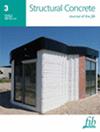轴向压缩下的纤维增强聚合物密实混凝土-钢双层管柱的机器学习和非线性有限元分析
IF 3.3
3区 工程技术
Q2 CONSTRUCTION & BUILDING TECHNOLOGY
引用次数: 0
摘要
纤维增强聚合物(FRP)约束双层管柱(DSTC)是一种创新型混合柱,由 FRP 制成的外管、内圆钢管和夹在两者之间的混凝土芯组成。现有文献主要关注空心 DSTC,而对内层钢管填充混凝土的 DSTC 研究有限。总体而言,DSTC 应用广泛,因此研究混凝土填充和强度对复合系统的影响非常重要。为了填补这一空白,研究人员利用有限元模型(FEM)以及传统和创新的机器学习(ML)技术开发了精确的模型,用于预测轴向载荷下的承载能力和约束极限应变。分析了包含 60 项实验测试和 45 项柱子有限元模拟的综合数据库,并选择了五个参数作为基于 ML 模型的输入变量。将梯度提升(GB)、随机森林(RF)、卷积神经网络和长短期记忆等新技术与多元线性回归、支持向量回归(SVR)和经验模式分解(EMD)-SVR 等成熟算法进行了比较。在评估这些模型的性能时,使用了回归误差特性曲线、夏普利加解分析和统计指标,数据库中包含 105 个涵盖一系列输入变量的 FEMs 测试结果。虽然 EMD-SVR 和 GB 在约束极限应变方面表现良好,但建议的 EMD-SVR、GB 和 RF 模型在约束极限载荷方面显示出更高的预测精度。更准确地说,在约束极限载荷预测方面,EMD-SVR、GB 和 RF 的预测值分别为 0.99、0.989 和 0.960。在约束极限应变时,GB 和 EMD-SVR 的值分别为 0.690 和 0.99。然而,设计工程师受限于 ML 的 "黑箱 "性质。为了解决这一问题,本研究提出了基于 GB 的开源图形用户界面,使工程师能够在各种测试条件下精确估算约束极限荷载和应变,从而对混合比例做出明智的决策。本文章由计算机程序翻译,如有差异,请以英文原文为准。
Machine learning and nonlinear finite element analysis of fiber‐reinforced polymer‐confined concrete‐steel double‐skin tubular columns under axial compression
Fiber‐reinforced polymer (FRP)‐confined double‐skin tubular columns (DSTCs) are an innovative type of hybrid columns that consist of an outer tube made of FRP, an inner circular steel tube, and a concrete core sandwiched between them. Available literature focuses on hollow DSTCs with limited research on DSTCs made with inner steel tubes filled with concrete. Overall, DSTCs have many applications, highlighting the importance of studying the effects of concrete filling and strength on the composite system. To address this gap, finite element models (FEMs) and both traditional and innovative machine learning (ML) techniques were used to develop accurate models for predicting load‐bearing capacity and confined ultimate strain under axial loads. A comprehensive database of 60 experimental tests and 45 FEMs simulations of columns was analyzed, with five parameters selected as input variables for ML‐based models. New techniques like gradient boosting (GB), random forest (RF), convolutional neural networks, and long short‐term memory are compared with established algorithms like multiple linear regression, support vector regression (SVR), and empirical mode decomposition (EMD)‐SVR. Regression error characteristics curve, Shapley Additive Explanation analysis, and statistical metrics are used to assess the performance of these models using a database containing 105 FEMs test results that cover a range of input variables. While EMD‐SVR and GB perform well for confined ultimate strain, the suggested EMD‐SVR, GB, and RF models show superior predictive accuracy for confined ultimate load. To be more precise, for confined ultimate load prediction, EMD‐SVR, GB, and RF obtain values of 0.99, 0.989, and 0.960, respectively. The values for GB and EMD‐SVR at confined ultimate strain are 0.690 and 0.99, respectively. However, design engineers are limited by the “black‐box” nature of ML. In order to solve this, the study presents an open‐source GUI based on GB, which gives engineers the ability to precisely estimate confined ultimate load and strain under various test conditions, enabling them to make well‐informed decisions about mix proportion.
求助全文
通过发布文献求助,成功后即可免费获取论文全文。
去求助
来源期刊

Structural Concrete
CONSTRUCTION & BUILDING TECHNOLOGY-ENGINEERING, CIVIL
CiteScore
5.60
自引率
15.60%
发文量
284
审稿时长
3 months
期刊介绍:
Structural Concrete, the official journal of the fib, provides conceptual and procedural guidance in the field of concrete construction, and features peer-reviewed papers, keynote research and industry news covering all aspects of the design, construction, performance in service and demolition of concrete structures.
Main topics:
design, construction, performance in service, conservation (assessment, maintenance, strengthening) and demolition of concrete structures
research about the behaviour of concrete structures
development of design methods
fib Model Code
sustainability of concrete structures.
 求助内容:
求助内容: 应助结果提醒方式:
应助结果提醒方式:


